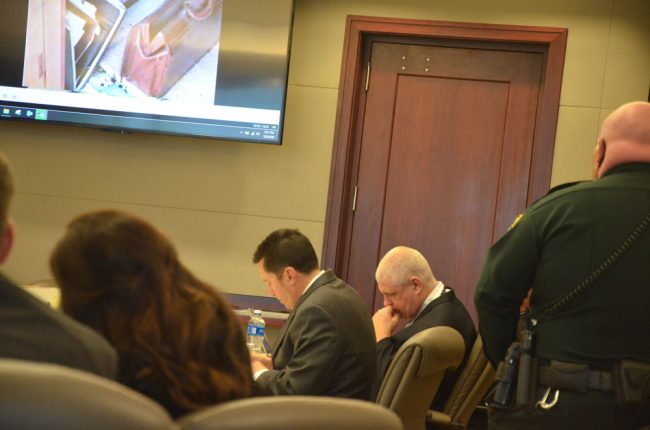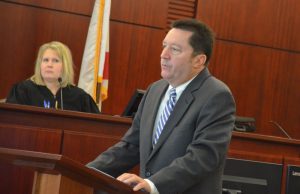
David Snelgrove’s guilt is not in question: he murdered Glyn and Vivian Fowler during a burglary at their B-Section home in Palm Coast in June 2000. He was convicted of the murders, the burglary and the robbery, and twice sentenced to die. Both sentences were vacated because of procedural and constitutional issues, but not the convictions. Snelgrove is back in court this week for yet another sentencing trial.
The 12-member jury has only one task: to decide whether to recommend the death sentence, or to let Snelgrove spend the rest of his life in prison without parole. He’s been in prison for two decades. The decision hinges on whether the jury will give more weight to the prosecution’s “aggravating” factors in the murders, or to the defense’s “mitigating” factors, especially Snelgrove’s mental disability.
So Snelgrove is not to be retried on the charges. But that’s what it looked like for much of the morning and afternoon today as Assistant State Attorneys Mark Johnson and Jennifer Dunton put their case to the jury: their witnesses, mainly law enforcement officers who’d investigated the crime in 2000, retraced their steps, a Florida Department of Law Enforcement analyst at the time, who took a video and pictures of the crime scene, gave the jury a picture by picture analysis of the bloody scene he’d filmed, many of the pictures showing the Fowlers bloodied, mutilated, dead, on the floor of their bedroom.
The prosecution’s strategy was clearly intended to shock the jury, and Snelgrove’s attorney, Michael Nielsen, raised objections before the lunch break ended and the jury returned. He said many parts of the testimonies and their details were not appropriate for this type of penalty-phase sentencing trials. The prosecution argued that all of it was necessary to prove what it has to prove beyond a reasonable doubt if it is to convince the jury to recommend death: six so-called “aggravators,” without which death may not be imposed.
Aggravators are such things as the brutality of the murders, the fact that Snelgrove was a previously convicted felon (he was on probation for a non-violent offense), the fact that the Fowlers were elderly and could not possibly have been able to defend themselves against an overpowering man in his prime, the fact that Snelgrove was committing a robbery at the time, and so on.
‘Some of it is not aggravation, it’s just prejudicial lobbing on to Mr. Snelgrove,” Nielsen argued to the judge. Snelgrove has been convicted, he said, all the elements of the crime have been proven beyond reasonable doubt. “Now, putting in physical evidence is prejudicial, that’s our position anyway,” he said, suggesting that the prosecution was coming close to crossing a line. “Some of this crime scene stuff just seems improper for this type of penalty phase proceeding.”
Dunton disagreed. She disputed Nielsen’s characterization of the guilt-phase proceedings. “The state is asking the jury to put this man to death,” Dunton said, citing the importance of removing all possibilities of doubt about the crimes. “They are entitled to see the nature and circumstances of the crime that was committed.” The evidence supports that, she said.

One of the key pieces of evidence in contention was a quarter-hour edited video of the crime scene, shown at all previous proceedings, that silently but in painful slowness pans over the Fowlers’ entire home, within and without, after the murders, before the crime scene was processed: they were still there, as in the pictures. Nielsen had concerns about the video being shown.
The judge viewed the video before the jury came in. As she did so, it was visible on all the screens in the courtroom–to Snelgrove at one end of the courtroom, and to two Fowler family members at the other, who sat with a victim’s advocate. They had seen the video before. It was no less distressing. Time heals wounds, not grief, and few people have to endure the graphic, forensic images of their parents after they’ve been murdered in a prolonged bout of violence.
The video was disturbing not only for its graphic images, but for the contrast between those images and what had preceded them: the pastoral, immaculate state of the Fowlers’ home, a typical reflection of the genteel comforts of a couple’s Florida retirement. The brief video, soundless, is in its way the complete story of a quiet home, of a home invasion, and of a double murder.
The video’s perspective begins from outside the house at 82 Banbury Lane: its enclosed pool, its well-tended grass, familiar, unremarkable, a well-kept house like so many in Palm Coast. Then the ripped screen and broken window: Snelgrove had cut the screen and smashed the window to break in. He’d cut himself in several places as he did so. There was a pair of lonesome sandals in the lanai, for smaller feet. Then drops of blood as the camera pans to the welcome mat at the kitchen door. More drops of blood on the linoleum, on a door frame.
In the living room, a stack of newspapers next to the television in a den kept as neatly as the rest of the house. (Snelgrove is watching as the video rolls, as intently as he’d looked at anything until then.) On a side table, paperwork and magazines (Woman’s World) under the TV remote. Then drops of blood on a wicker chair’s cushions. In an unused bedroom, an open clothes closet and a dresser, many of its drawers partly open: Snelgrove had rummaged through the place, looking for cash to feed his crack addition. Back in the living room area, the oversize doll of a little girl as if playing with her toys on a chair in the living room, not far from a bloody footprint on the carpet–distinct, like a footprint on beach sand, but dark red against the tan carpet–then another, and another, leading to the front door, where Snelgrove had exited. A few pairs of shoes had been left neatly arrayed against the wall.
Only then the camera pans into the Fowlers’ bedroom, where they are on the floor by the bed. In the courtroom, Snelgrove is no longer looking up. He is resting his face on his left hand, his head bowed, and seems to be crying. He is clearly uncomfortable.
One of the two Fowler family members had kept looking at the screen. The other–the Fowlers’ daughter–had had her head bowed the entire time. The courtroom was silent throughout. The video ended shortly afterward.
“I don’t find it is overly prejudicial,” the judge said, allowing the video to be shown.
Nielsen then raised another concern: he did not want the Fowler family members’ reactions–whether bowed, averted from the screen or emotional–to influence the jury and proposed having the judge ask them to remove themselves from the courtroom during the showing of the video.
Johnson, the assistant state prosecutor, disagreed. “They’ve seen this before, this is not their first time, this is the third time, and they’ve been here every step of the way. It’s simply that they don’t want to see it again,” Johnson said. “They have a right to be here, and as long as they’re able to keep their composure and not draw attention to themselves or their emotional state, I think they should be allowed to remain here.” Johnson said their bowed demeanor was no different than that of Snelgrove, who’d also put his head down.
Weston agreed that demeanor in the gallery “is a sign to the jury,” and can risk influencing the proceedings. “Even if it’s just looking down, looking away, those are the kinds of things that could require potentially for this to be redone,” the last thing anyone wants at this point, she said. But she left it to people in the gallery to not draw attention to themselves. “I’m not going to require anybody to leave the courtroom,” Weston said.
The jury was called in. The former FDLE official went through his analysis of the pictures, then the video was shown. This time Snelgrove kept his head bowed throughout. The jury’s eyes were riveted on the screen. There was no movement in the gallery.
The rest of the day was devoted to a succession of prosecution witnesses (or the reading of written transcripts of witnesses who could no longer be present) who were involved in the investigation or prior proceedings, including the very brief testimony of Randy Fowler, the Fowlers’ son who could not leave California this time, because of health reasons. Fowler spoke of the necklace he’d given his mother as a present three years before the murders, the necklace Snelgrove stole and pawned at a Holly Hill pawn shop–for $25: that’s what the life of Glyn Fowler, 84, and Vivian Fowler, 79, at the time of the murders, came down to in Snelgrove’s hands.
Two separate juries, in 2002 and in 2008, could not unanimously agree to recommend death for Snelgrove, splitting 7-5 and 8-4. It’s because the law now requires a unanimous verdict for death that Snelgrove is being re-tried. If there’s no unanimity again, he will remain in prison for the rest of his life, without parole.
The lawyers and the judge were not allowed to speak of the case’s procedural history to the jury, so as to prevent the jury from making assumptions about those various steps. That’s why the case was being presented to them as if it had just been tried, as if 20 years had not elapsed since the murders, though the dates could not be avoided.

“There’s no question, it’s common sense, to understand that what happened that night in that home was horrible,” Nielsen, Snelgrove’s attorney, said in his opening argument. “Two people in their home minding their own business, and that’s the truth, and the defendant can’t get away from it. But like we talked about in jury selection: not all murders deserve the death penalty. I mean, lets face it, all murders are horrible. I can’t think of an example of a murder that’s not. Now, what we’re going to do is present to you not a defense, not an excuse, that’s not what this is about, because there is no excuse. But perhaps there is some explanation as to how we got to this point, that we feel is very important for you folks to consider, and that’s why you’ll hear mitigating circumstances.”
Nielsen and Snelgrove hope that those mitigating circumstances are again compelling enough for the jury not to find its way to a unanimous recommendation for death–and thus, in Nielsen’s words, to “leave him where he’s at, let him finish out his life in prison without parole.”
The trial is expected to extend to next week.





























Bob Carlton says
This case is so cut and dried why has the Florida judicial system just stop all the sentencing hearings give Snelgrove the death penalty and move on. Nothing will undo what he did to the Fowlers. What has this cost the state? The prosecution attorneys are civic employees and all their time and the time of any support staff is paid for by taxpayers. I’m sure that the defense attorneys are not working pro bono so their costs are taxpayer funded. Enough is enough.